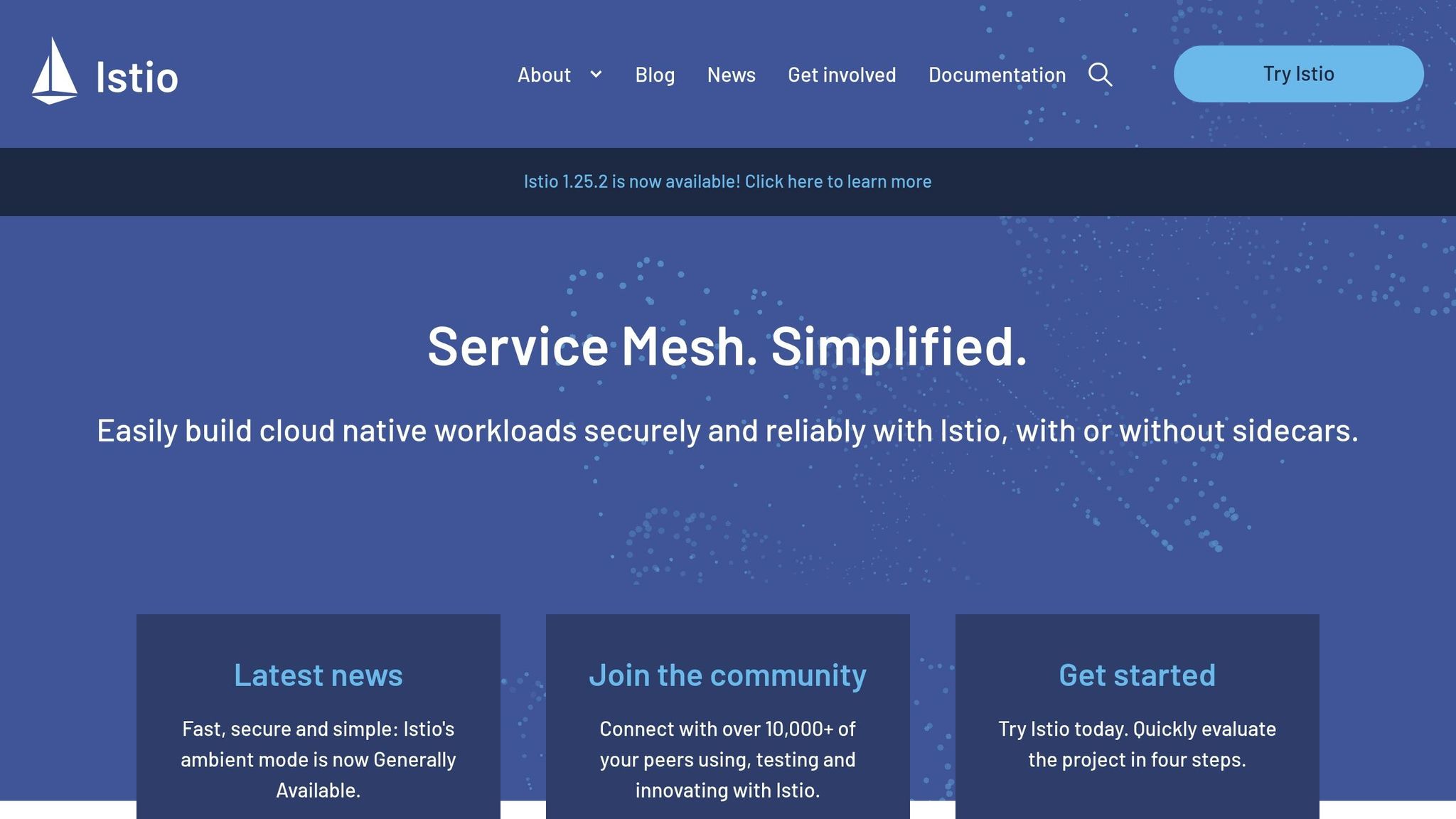5 Tips for Multi-Cloud Microservices Networking

Managing multi-cloud microservices networks can be challenging, but the right strategies ensure smooth communication, high performance, and strong security. Here's a quick summary of the key solutions:
- Use Service Mesh: Simplify communication between microservices with features like service discovery, traffic management, load balancing, and encryption.
- Build Strong Infrastructure: Use direct interconnects, SD-WAN, or VPN tunnels for reliable cross-cloud connections. Place services close to data sources and user bases to reduce latency.
- Add API Gateways: Control traffic, enforce security, and optimize performance with centralized management of requests and protocols.
- Monitor Performance: Track latency, throughput, and error rates in real time to identify and resolve issues quickly.
- Secure Your Network: Implement zero-trust security, use mTLS, segment networks, and protect APIs to safeguard data and services.
Quick Tip: Tools like Endgrate can simplify integration and management across multiple clouds. By combining these strategies, you can build a secure, efficient, and reliable multi-cloud network.
Secure multi-cloud microservices with Istio Part-1 | Istio Demo ...

Use Service Mesh for Better Communication
Service mesh technology simplifies secure and efficient communication between microservices, even when spread across multiple clouds. Here's a closer look at how service meshes operate in multi-cloud environments.
How Service Meshes Work in Multi-Cloud
A service mesh acts as a management layer that oversees communication between microservices, no matter where they are hosted. This layer takes care of essential tasks like:
- Service Discovery and Traffic Management: Automatically identifies and optimizes the flow of data between services.
- Load Balancing: Distributes incoming traffic evenly to avoid overloading any single service.
- Encryption: Secures communication with automatic management of TLS certificates.
Each service instance is paired with a proxy sidecar. These proxies intercept all network traffic, ensuring consistent enforcement of policies and monitoring across the entire system.
| Service Mesh Component | Primary Function | Multi-Cloud Benefit |
|---|---|---|
| Proxy Sidecar | Intercepts Traffic | Ensures consistent networking across clouds |
| Control Plane | Manages Configuration | Centralizes policy enforcement |
| Data Plane | Handles Communication | Secures cross-cloud traffic |
| Service Registry | Tracks Service Locations | Automates service discovery |
Benefits of Using a Service Mesh
Service meshes bring several advantages to multi-cloud microservices environments:
Increased Reliability
- Automatically retries failed requests, breaks problematic circuits, and balances traffic based on service health.
Stronger Security
- Implements mutual TLS (mTLS) encryption by default.
- Enables identity-based authentication between services.
- Allows detailed access control policies.
Improved Observability
- Collects real-time metrics.
- Offers detailed visualizations of traffic flows.
- Provides end-to-end request tracing.
Streamlined Network Management
- Centralizes configuration, enforces policies across environments, and automates certificate handling, making multi-cloud operations more manageable.
Set Up Strong Network Infrastructure
Creating reliable network connections across multiple cloud environments takes careful planning to ensure everything runs smoothly.
Connect Clouds Effectively
Choosing the right connectivity solution is key when linking multiple cloud environments. Here's a quick breakdown of options:
| Connection Type | Best Use Case | Key Benefits | Considerations |
|---|---|---|---|
| Direct Cloud Interconnects | Production workloads | Dedicated bandwidth, private routing | Higher cost |
| SD-WAN | Distributed applications | Intelligent path selection | Hardware requirements |
| VPN Tunnels | Development/testing | Quick deployment | Variable performance |
Using a mix of these connection types can provide extra redundancy. Once connections are set, the next step is to carefully position your services for optimal performance.
Place Services in the Right Location
Where you place your services can make or break your network's performance and the user experience:
- Data Gravity: Keep microservices close to their main data sources. This reduces latency and saves on data transfer costs. Similarly, deploy services near your largest user bases for faster access.
- Service Dependencies: Group services that rely heavily on each other in the same cloud region. This improves communication between microservices.
- Geographic Distribution: Spread critical services across multiple regions. This ensures availability and better response times for users worldwide.
Build Backup Connections
Redundancy is essential for uninterrupted operations. Here's how you can prepare for the unexpected:
- Multi-Region Failover: Host critical services in both primary and backup regions. Use automated failover systems and regularly test them to ensure they work when needed.
- Cross-Cloud Routing:
- Active-Active Configuration: Run services across multiple clouds simultaneously.
- Load Balancing: Spread traffic across different paths to avoid bottlenecks.
- Health Monitoring: Keep an eye on connection status to detect issues early.
These methods strengthen your network's reliability. For easier integration management, consider tools like Endgrate to streamline the process.
sbb-itb-96038d7
Add API Gateways to Control Traffic
API gateways are essential for managing communication between microservices in multi-cloud environments. Think of them as traffic controllers, ensuring data flows efficiently while keeping security and performance in check.
What Do API Gateways Do?
API gateways serve as the main access point for all microservices traffic. They handle tasks like:
- Traffic Management: Routing requests and balancing loads efficiently.
- Request Consolidation: Combining multiple service calls into one to minimize overhead.
- Protocol Translation: Bridging different communication protocols.
- Caching: Storing frequently requested data to improve response times.
Let’s explore how these features work in real-world scenarios.
Core Functions of API Gateways
API gateways improve multi-cloud microservices by offering several critical features:
Traffic Control
- Limiting request rates.
- Throttling excessive traffic.
- Dynamically routing requests.
- Providing automatic failover for reliability.
Security and Authentication
- Centralized user authentication.
- Validating incoming requests.
- Encrypting sensitive data.
- Enforcing access control rules.
Monitoring and Analytics
- Analyzing traffic in real time.
- Tracking performance metrics.
- Monitoring error rates.
- Identifying usage trends.
Resource Optimization
- Reducing unnecessary service calls.
- Using smart caching to improve efficiency.
- Automating load distribution across services.
For seamless integration, consider using platforms like Endgrate. Their unified API connects with over 100 third-party services, cutting down development time and ensuring consistent performance in your microservices setup.
Track Network Performance
Monitoring your network in real time helps you spot bottlenecks and avoid problems in multi-cloud microservices.
Live Monitoring Tools
Keep an eye on these key metrics:
- Latency: Measure how long it takes for services to respond.
- Throughput: Track how many requests are processed per second and the data transfer rates.
- Error Rates: Look out for failed requests or timeouts.
- Resource Usage: Monitor CPU, memory, and network bandwidth.
With Endgrate's unified API monitoring dashboard, you can track network latency, API response times, service availability, and resource usage - all in real time. This data allows you to make quick adjustments to your resources as needed.
Adjust Resources Based on Data
Improving network performance starts with taking action based on the metrics you collect.
Dynamic Resource Allocation
- Monitor service usage patterns.
- Pinpoint peak traffic times.
- Automatically scale resources and distribute loads across regions.
Steps to Improve Performance
1. Establish Baseline Performance
- Define acceptable thresholds for your services.
- Document typical usage patterns.
2. Analyze Trends
- Identify recurring bottlenecks.
- Locate operations that consume the most resources.
- Track when and where peak usage happens.
3. Make Adjustments
- Reallocate resources, move services, or tweak routing rules as needed.
Use the monitoring data to dig into root causes, find which services are affected, apply precise fixes, and confirm that the changes improve performance.
Keep Multi-Cloud Networks Secure
After fine-tuning performance and managing traffic, security becomes the cornerstone of maintaining reliable multi-cloud microservices. It's essential to safeguard your data and services without slowing things down. Here's how to secure your multi-cloud environment effectively.
Use Zero-Trust Security
Zero-trust security assumes that no connection is inherently safe. This mindset is crucial in multi-cloud setups, where services operate across various networks and providers.
Key Elements of Zero-Trust Security
- Identity Verification: Every service must confirm its identity before accessing any resources.
- Least Privilege Access: Services only get the permissions they absolutely need to perform their tasks.
- Continuous Monitoring: Keep an eye on all network connections in real time to ensure security.
Endgrate simplifies this process by automating service identity checks and enforcing detailed access controls.
Microservices Security Measures
Building on zero-trust principles, these specific steps will enhance your multi-cloud security:
1. Use mTLS for Service Verification
mTLS (mutual TLS) ensures both ends of a service connection are verified, blocking unauthorized access.
2. Implement Network Segmentation
Divide your network into smaller, isolated sections to reduce risk:
- Separate sensitive data services from public-facing ones.
- Use virtual networks to isolate different environments.
- Define network policies to control how traffic flows between segments.
3. Protect API Communications
Secure APIs with these strategies:
- Apply rate limits to prevent overload.
- Validate incoming requests to filter out harmful traffic.
- Regularly rotate API keys to reduce exposure risks.
- Use encryption to protect data both at rest and during transit.
4. Use Cloud-Native Firewalls
Modern cloud firewalls offer features like deep packet inspection, application-level security, and automated threat detection.
5. Enable Audit Logging
Keep a record of all service interactions, authentication attempts, and resource usage:
- Analyze resource access trends.
- Store logs securely to meet compliance standards.
- Track security incidents across your cloud environments.
Endgrate's platform includes built-in tools for automated logging, encrypted data transfers, and unified access control, ensuring your multi-cloud setup remains secure.
Conclusion
Managing multi-cloud microservices networking requires strategies that prioritize performance, reliability, and security. Building a dependable network infrastructure with redundant connections and carefully placing services ensures your applications stay responsive and resilient. Tools like service meshes can simplify communication between services.
API gateways play a key role in managing traffic, handling tasks like rate limiting and request validation. Pair these with real-time monitoring to make data-driven decisions for optimizing resources.
Strengthen your microservices setup with zero-trust architecture, network segmentation, and encrypted communication. Using platforms like Endgrate can simplify integration management, ensuring consistent and efficient communication across multi-cloud environments. Together, these practices create a solid framework for your multi-cloud approach.
As your architecture grows and changes, regularly reviewing and updating these strategies will help maintain a secure, reliable, and efficient multi-cloud network.
Related posts
Ready to get started?
